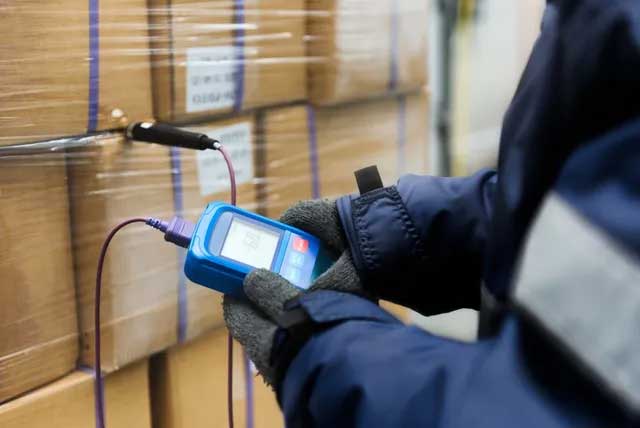Temperature Mapping
Temperature Mapping Services in Ireland
Why Temperature/RH Mapping?
Clause 3.19 of the PIC/S GMP guide states:
“Storage areas should be designed or adapted to ensure good storage conditions. They should be clean and dry and maintained within acceptable temperature limits. Where special storage conditions are required (e.g., temperature, humidity) these should be provided, checked and monitored.”
What will happen if?
- Your facility lost power over a weekend? Would you be set back months or even years in research and development?
- Your refrigerator motor short circuits? Would you have to discard valuable material or otherwise sellable inventory?
- You were faced with a surprise audit? Is your QA team ready? Do you readily have the documentation to avoid a deviation?
Facility, warehouse, laboratory equipment and storage area temperature/RH mapping services
Micron provides Turnkey ((As a project from protocol to report) thermal validation/mapping in Entire facility which includes clean rooms, QC laboratory and warehouses as well as freezer rooms, cold rooms, temperature-controlled storage areas, quarantine areas and receiving and loading bays etc. Thermal validation/ mapping is performed as per WHO guidelines, PICS, Food and Drug Administration (FDA) or as per ICH.
Temperature & RH Measurement
We conduct validation tests that include Temperature and Humidity Measurements / Tests. Two levels of temperature and humidity tests are used by us depending on the requirement. In the first level, general temperature and humidity uniformity are tested. The general level test is used to ensure that the clean room's HVAC system maintains the specified levels of temperature and humidity required for occupant comfort. The second level or the comprehensive level test identified that the clean room HVAC systems needs to maintain the specified levels of temperature and humidity required for both occupant comfort and process temperature control.
Cold Rooms, Warehouse and Room Mapping
The Cold Chain Validation suddenly became a hot topic when the results of a government investigation into Cold Chain distribution compliance were published. The facts release indicated that nearly a quarter (23 & precnt;) of all drugs distributed in the USA, are of unknown efficacy. The distribution of these temperature sensitive products in vehicle containers that lacked validated methods of maintaining the correct internal temperature or even the ability to produce a validated history of what the actual conditions were; has rendered these products 'adulterer', i.e., of unknown efficacy or safety. Vehicle body internal temperatures:
- With seasonal variations, can range from a high of 50 to a low of -40 (degrees centigrade). In contrast the mandated internal temperature for distribution containers for standard drugs and medical products is 2 to 8 (degrees centigrade), with much lower temperatures specified for some drugs.
- This shocking news has certainly guaranteed that Cold Chain Validation compliance will be top of everyone's audit list, specifically when drug interactions with the end user are considered as critical. The implications of products being damaged and out of specification may induce many companies to replace doubtful goods or even trigger the regulators into initiating product recalls. This problem is expected to create a veritable stampede as distributors scramble to ensure that all the vehicles and containers they used in this essential everyday service, are rendered Cold Chain compliant, as soon as is possible.
Cold Rooms, Warehouse and Room Mapping
The Cold Chain Validation suddenly became a hot topic when the results of a government investigation into Cold Chain distribution compliance were published. The facts release indicated that nearly a quarter (23 & precnt;) of all drugs distributed in the USA, are of unknown efficacy. The distribution of these temperature sensitive products in vehicle containers that lacked validated methods of maintaining the correct internal temperature or even the ability to produce a validated history of what the actual conditions were; has rendered these products 'adulterer', i.e., of unknown efficacy or safety. Vehicle body internal temperatures:
With seasonal variations, can range from a high of 50 to a low of -40 (degrees centigrade). In contrast the mandated internal temperature for distribution containers for standard drugs and medical products is 2 to 8 (degrees centigrade), with much lower temperatures specified for some drugs.
This shocking news has certainly guaranteed that Cold Chain Validation compliance will be top of everyone's audit list, specifically when drug interactions with the end user are considered as critical. The implications of products being damaged and out of specification may induce many companies to replace doubtful goods or even trigger the regulators into initiating product recalls. This problem is expected to create a veritable stampede as distributors scramble to ensure that all the vehicles and containers they used in this essential everyday service, are rendered Cold Chain compliant, as soon as is possible.
Stability Chamber
Stability chambers are ideal for testing storage, shelf life, packaging, and stability. Stability chambers are available in temperature only or with temperature and humidity. Sizes range from reach-in to walk-in and most chambers feature a temperature range of -20° C to 60° C and an optional humidity range from 10% to 95% RH.
Stress testing is likely to be carried out on a single batch of the drug substance. It should include the effect of temperatures in 10° C increments (50° C, 60° C, etc.). Increments may be greater for accelerated testing. Stress testing for humidity typically is performed at 75% RH or greater (where appropriate).
Other tests can include effects of oxidation and photolysis. Stress testing of the drug substance can help identify the likely degradation products, which can in turn help establish the degradation pathways and the intrinsic stability of the molecule. It can also validate the stability indicating power of the analytical procedures used. The nature of the stress testing will depend on the individual drug substance and the type of drug product involved.
Temperature mapping/validation is performed using 21 CFR part - 11 compliance software
Our Services
Israel
- GMP Auditing
- GMP Training
- Pharma Microbiology
- Pharma Quality Management System
- Aseptic Processing
- Pharma Regulatory Services
- USFDA Consultant
- GMP Consultancy
- HVAC Design Consultants
- HVAC Consultant
- Cleanroom Validation Services
- Operation Theatre Validation
- Thermal Validation
- PLC Validation
- Compressed Air Validation
- Temperature Mapping
- HVAC System Validation
- HVAC System in Pharmaceutical Industry
- HVAC Validation Services
- Pharma Consultant
- Biotech Consultant
- Biopharma Consultant
- Biopharmaceutical Consultant
- Biopharma Regulatory Consultant
Saudi Arabia
- GMP Auditing
- GMP Training
- Pharma Microbiology
- Pharma Quality Management System
- Aseptic Processing
- Pharma Regulatory Services
- USFDA Consultant
- GMP Consultancy
- HVAC Design Consultants
- HVAC Consultant
- Cleanroom Validation Services
- Operation Theatre Validation
- Thermal Validation
- PLC Validation
- Compressed Air Validation
- Temperature Mapping
- HVAC System Validation
- HVAC System in Pharmaceutical Industry
- HVAC Validation Services
- Pharma Consultant
- Biotech Consultant
- Biopharma Consultant
- Biopharmaceutical Consultant
- Biopharma Regulatory Consultant
UAE
- GMP Auditing
- GMP Training
- Pharma Microbiology
- Pharma Quality Management System
- Aseptic Processing
- Pharma Regulatory Services
- USFDA Consultant
- GMP Consultancy
- HVAC Design Consultants
- HVAC Consultant
- Cleanroom Validation Services
- Operation Theatre Validation
- Thermal Validation
- PLC Validation
- Compressed Air Validation
- Temperature Mapping
- HVAC System Validation
- HVAC System in Pharmaceutical Industry
- HVAC Validation Services
- Pharma Consultant
- Biotech Consultant
- Biopharma Consultant
- Biopharmaceutical Consultant
- Biopharma Regulatory Consultant
Nigeria
- GMP Auditing
- GMP Training
- Pharma Microbiology
- Pharma Quality Management System
- Aseptic Processing
- Pharma Regulatory Services
- USFDA Consultant
- GMP Consultancy
- HVAC Design Consultants
- HVAC Consultant
- Cleanroom Validation Services
- Operation Theatre Validation
- Thermal Validation
- PLC Validation
- Compressed Air Validation
- Temperature Mapping
- HVAC System Validation
- HVAC System in Pharmaceutical Industry
- HVAC Validation Services
- Pharma Consultant
- Biotech Consultant
- Biopharma Consultant
- Biopharmaceutical Consultant
- Biopharma Regulatory Consultant
Ireland
- GMP Auditing
- GMP Training
- Pharma Microbiology
- Pharma Quality Management System
- Aseptic Processing
- Pharma Regulatory Services
- USFDA Consultant
- GMP Consultancy
- HVAC Design Consultants
- HVAC Consultant
- Cleanroom Validation Services
- Operation Theatre Validation
- Thermal Validation
- PLC Validation
- Compressed Air Validation
- Temperature Mapping
- HVAC System Validation
- HVAC System in Pharmaceutical Industry
- HVAC Validation Services
- Pharma Consultant
- Biotech Consultant
- Biopharma Consultant
- Biopharmaceutical Consultant
- Biopharma Regulatory Consultant
Bangladesh
- GMP Auditing
- GMP Training
- Pharma Microbiology
- Pharma Quality Management System
- Aseptic Processing
- Pharma Regulatory Services
- USFDA Consultant
- GMP Consultancy
- HVAC Design Consultants
- HVAC Consultant
- Cleanroom Validation Services
- Operation Theatre Validation
- Thermal Validation
- PLC Validation
- Compressed Air Validation
- Temperature Mapping
- HVAC System Validation
- HVAC System in Pharmaceutical Industry
- HVAC Validation Services
- Pharma Consultant
- Biotech Consultant
- Biopharma Consultant
- Biopharmaceutical Consultant
- Biopharma Regulatory Consultant


